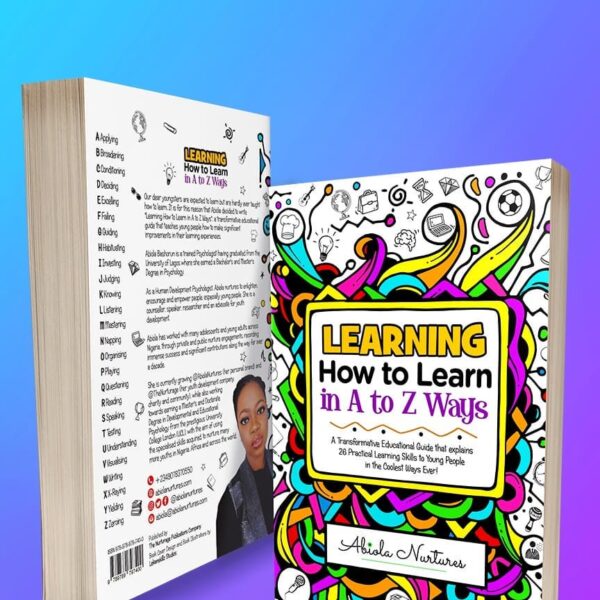Learning never exhausts the mind. It is the one thing that we cannot stop doing until we cease to live. Either formally or informally, it is what keeps our minds active and alive. In Abiola Nurtures’ Learning How to Learn in A-to-Z Ways, we are introduced to an alphabetical way of expanding our mental bandwidth. She simplifies the learning process with the English alphabet, exploring the 26 different ways we can maximize our learning abilities.
In Applying, we are shown the best way to apply knowledge directly, indirectly, for immediate use and for future use. Subsequently, Abiola moves on to B, which is Broadening. This chapter is about stretching the brain with new knowledge. With broadening, you can zoom in, zoom out, zoom through, categorize, map between new and previous knowledge and increase the knowledge you acquire. In Knowing, we learn that knowing is the forerunner of understanding. We know from our senses, we know from our mind and we know from seeking. We learn in Questioning that the hallmark of a true learner is the ability to actively ask important questions. Abiola uses Oprah Winfred’s superior ability to frame interview questions as a relevant analogy. These are exciting ways to learn about how much the brain can take and as it stands, the brain can take in 34GB of information in a day. Abiola moves through the alphabets swiftly, introducing and elucidating concepts that can facilitate effective learning.
One of the striking feats that Abiola manages to achieve in this book is the ability to provide accurate words for each letter of the alphabet that are relevant to learning in one way or another. These words have the potential to influence a new attitude towards learning. For instance, the letter J, which stands for Judging is one of the distinctive chapters. We all know the importance of making well-thought decisions and Abiola pinned judging as “the evaluation of available evidence in order to make informed decisions.” It is arguably an exhaustive chapter on what judgement means to our learning capacities. It illuminates the concept of SWOT; how to judge strengths, weaknesses, opportunities and threats.
According to her, the difference between people that constantly pass, and fail could lie in how well they judge their strengths, weaknesses, opportunities and threats. Knowing the best time to study, what works and what does not work all lie in perfecting your SWOT analysis. Abiola also emphasizes the need to toot one’s horn in another chapter and this does not have anything to do with being supercilious or self-important. It is more about being aware of one’s strengths, being self-assured and at the same time being humble. She is particular about owning your greatness. She says, “Walk in the knowledge of all your strengths and never apologise to anybody for it.”
Learning should not be a herculean task nor should it be fraught with confusion. It is a lifelong process, whether we actively participate in it or not. In the case of formal learning, this book is a gem. It is a detailed, organised, well-researched, and, at the risk of sounding like a broken record, an insightful 284-paged book. From it, you’ll learn that speaking is not more important than listening nor is x-raying better than visualising. As a matter of fact, each word that the alphabet stands for is a key element in the attainment of excellence in the learning journey.
Learning How to Learn in A to Z Ways is perfect for students or anyone studying formally and needs to be intentional about it. It is not advisable to just cruise through school without actively seeking ways to go above and beyond for those seemingly difficult subjects. This book is an adequate resource on how to align your goals with your abilities so you can get the desired result. Teachers and parents should read this book as they are people with influence in the lives of students. There are so many teachable lessons that both parties can impact upon students in order to foster improvement in their attitude to learning.
It is widely believed that self-help books have the potential to bore you to death. This is not the case with Learning How to Learn in A to Z Ways. There is nothing boring about the book cover neither is there any tendency for the content to elicit boredom. It is written in the simplest way for easy comprehension. The storytelling done through the illustrations that span the book is noteworthy. It fuels interest, piques curiosity and further expounds on the subject matter. This book should be a staple in homes and classrooms.
Share your story or advertise with us: Whatsapp: +2347068606071 Email: info@newspotng.com













